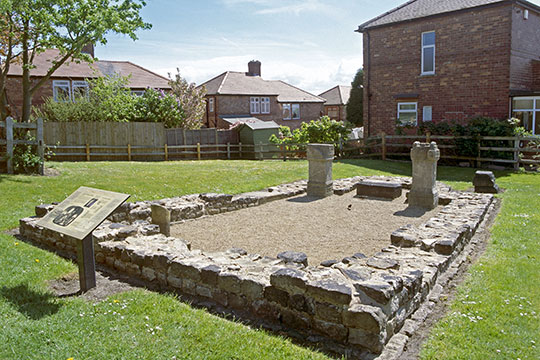History of Benwell Roman Temple
The fort at Benwell (Condercum) – one of 13 permanent forts along the line of Hadrian’s Wall – was occupied throughout most of the Roman period by the cavalry regiment ala I Asturum. It is no longer visible, its site covered on the north side by a Victorian reservoir and to the south by 1930s housing. Sixty metres east, however, is a temple dedicated to a local god, Antenociticus, which once stood within the civilian settlement outside the fort. To the south is another associated site, the only permanent crossing of the Vallum earthwork to be seen on the line of Hadrian’s Wall.

The Temple and Its Dedications
We know from one of the three altar inscriptions found at the site that the temple had been built by about AD 178–80. The altar was dedicated to the god Antenociticus by the cavalry prefect Tineius Longus, who had been designated as a quaestor. This entitled him to have the broad stripe of a senator on his toga, as is stated on the inscription, which was probably erected to mark his promotion.[1]
Of the other altars, one was dedicated by a centurion of the Twentieth Legion (Valeria Victrix), who was possibly in temporary command of the unit at Benwell. The other was dedicated by a prefect of the first cohort of Vangiones, who were originally recruited from the Rhineland. He was perhaps a commander at Benwell before the arrival of the Asturians (the cavalry unit ala I Asturum from northern Spain, which was stationed at the fort from the early 3rd century), if not a visitor to the shrine.[2]
The most famous find from the temple is the head of a youthful god, ‘a synthesis of classical and non-classical stylistic elements’.[3] Antenociticus is not mentioned at any other Romano-British site or on any inscriptions from the Continent, and is therefore thought to be a local deity.
Later History of the Temple Area
The latest coin recovered from the temple was an issue of the emperor Marcus Aurelius (AD 161–80). Records of burnt timbers and roof tiles have led to suggestions that it was destroyed by enemy action in the late 2nd century. But only five legible coins have been found from the temple, so the date of its destruction cannot be regarded as certain.[4]
At some stage during the Roman period the surrounding area seems to have been used as a cemetery, and three skeletons were found in the apse of the temple.[5] In 1935, immediately west of the temple, two brooches dating from the 6th- or early 7th-century and a glass vessel, probably associated with Anglo-Saxon burials, were found when the present street was built.[6]
By Paul Bidwell
READ MORE ABOUT BENWELL ROMAN TEMPLE
DOWNLOAD A LOCATION PLAN OF BENWELL ROMAN TEMPLE AND VALLUM CROSSING
Footnotes
1. RG Collingwood and RP Wright, The Roman Inscriptions of Britain, vol 1: Inscriptions on Stone (Oxford, 1965), no. 1329. The altar is now in the Great North Museum, Newcastle.
2. Ibid, nos 1327–8 (also in the Great North Museum).
3. EJ Phillips (ed), Corpus Signorum Imperii Romani, vol 1, fascicule 1: Corbridge, Hadrian’s Wall East of the North Tyne (Oxford, 1977), no. 232.
4. GW Rendal (recte Rendel), ‘The Benwell discoveries’, Archaeologia Aeliana, 2nd series, 6 (1865), 170 (accessed 26 November 2012).
5. Ibid, 169.
6. P Brewis, ‘A cruciform brooch from Benwell, Newcastle upon Tyne’, Archaeologia Aeliana, 4th series, 13 (1936), 117–21; G Jobey and D Maxwell, ‘A square-headed brooch from Benwell’, Archaeologia Aeliana, 4th series, 35 (1957), 282–4.